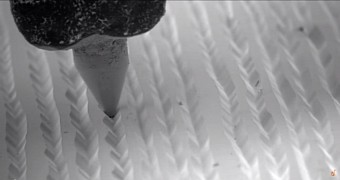Using the Electron Microscope, the guys from Applied Science made an extremely interesting video on how the magnetic needles interact with grooves on the LP itself, creating, evidently, sound.
Basically, until the invention of the CD-ROM in the late '80s, the technology to play music didn't change since the 19th century sound cylinders. You basically take a circular object, being a disk or a cylinder made of sensitive material, grab an object with a rubber or anything elastic in the form of a membrane, and attach a needle to the bottom. The needle needs to be strong, and the cylinder material sensitive enough so that your voice's sound wave could carve grooves on the material through the attached needle.
Add another needle to read those grooves, and an amplifier so that the scratching could be heard, and the classic LPs come to life.
The guys from Applied Science show us how a needle moves around those grooves and how the vibrations touch a coil that gives electrical signals to amplifiers that later create sound.
It's fascinating work, and it becomes even more incredible when you actually realize how it happens and how much work has been done to actually see where and how sound can take physical form.
Kudos to the Rocky album, and check out the defunct Selectavision CED disk. The Selectavision had the magnetic needle read the number of tracks instead of the grooves, so the density of the disk was twice as high than the normal LPs.
It's fascinating work and i'm impressed by how much work one man can put in creating one "electron" gif!

 14 DAY TRIAL //
14 DAY TRIAL // 